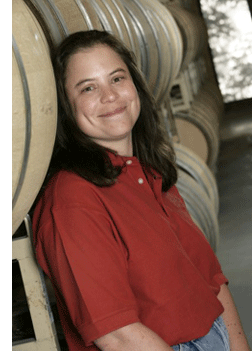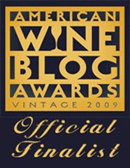Introducing Julie...
9 Comments
Leave a comment
welcome!
This is a blog about what it's really like to be in the wine industry...so sit back, take a sip and enjoy!

about me

our wines

our winery

our events

contact me

privacy statement

favorite posts
A Lifetime in Wine
Top 10 Traits of the Successful Family Winery
The Dreaded Family Meeting
Board Meeting Jitters
Is the Future of the Winery in Danger?
The Case of the Overweight Bottle
Wine and Dementia
Wanted: Talented (Normal) Individual for Family Owned Winery
A Sea of Wine
The Heroes of Our Industry
monthly archives
subscribe
Hopes & Dreams
Owning a Coastal Cottage
Sailing for 6 Months
Getting a 100 Point Score

Favorite Haunts
Coast of Maine
Dry Creek General Store
Dry Creek Kitchen
Healdsburg Bar & Grill
Spoonbar
Sonoma Country Antiques
Baci Cafe & Wine Bar
The Farmhouse
Istanbul's Grand Bazaar
Bad Ass Coffee
Bistro Ralph

Bits of Press
Food & Wine Magazine
The Wine News
Wine Enthusiast
Wine Spectator
Press Democrat
Sunset Magazine
Connoisseurs' Guide
Dan Berger's Vintage Experiences
Cruising World Magazine
Oprah Magazine
The Washington Post
Coastal Living Magazine
Wine & Spirits Magazine
People Magazine
SAG Awards Magazine
Forbes Magazine

Favorite Magazines
Coastal Living
Down East
Sunset
Country Living
Quarterly Review of Wines
Wines & Vines
Wine Spectator
Wine Enthusiast
California Grapevine
Connoisseurs' Guide
Practical Winery & Vineyard
WineReviewOnline
Vineyard & Winery Mgmt

Blog Buddy List
Fermentation
Hip Tastes
Pinot Blogger
All The Best
Julia Flynn Siler
Vinography
Winery Web Site Report
The Pour - Eric Asimov
Dr Vino
Steve Heimoff
Start Up Ladies
Good Wine Under $20
Blind Muscat
The Wineroad Blog
Gabe's View
Wine Peeps
Vici Vino
Cellarmistress' Cellar Talk
Uncork Life
WineVine-Imports Blog
The Wine Witch
SOURMASHED

Honorable Mentions
Fermentation
Wilma Hits The World of Blogs
Most Intriguing New Wine Blogs of 2008
Midwest Wine Guy
Winery of the Month
Julia Flynn Siler
Meritage wines - and a fascinating glimpse into family business
Winery Web Site Report
New Winery Blog: Wilma's Wine World
Start Up Ladies
Insider's View of Family Owned Dry Creek Vineyard
The Glue that Keeps the Whole Thing Going
Atlanta Dish
Blog of the Week
Blind Muscat
The Merits of Meritage
Wineries.net
Boston Wine Expo exhibitors, and the reason why winemakers are so darn happy





Rhoda Coben said:
March 17, 2011 8:08 PM
I enjoyed this so much. You have the best smile as well as being a fabulous wine maker. We will be enjoying your wine. Keep up the great work. Can't believe that you have accomplished so much. I can't be that old. Love, Rhoda
Julie
March 18, 2011 8:51 AM
Rhoda,
Thanks so much for the glowing comments. I appreciate your good wishes and support...
JohnLopresti
March 19, 2011 12:17 PM
Welcome the winemaker. I liked the technical part of the post, and would like to hear more about the progress of the malo-lactic, for this harvest.
Julie
March 21, 2011 9:07 AM
Here at Dry Creek Vineyard we do not inoculate to go through malo-lactic fermentation (MLF. So, we are dependent on things happening naturally. It takes some patience. One trick is to listen to the barrels. You can hear when the MLF is happening. Then you can use that barrel for topping other barrels.
JohnLopresti
March 21, 2011 12:30 PM
I had a pump work order once to aerate cab sauv. Throughout, I felt inducing oxygenation of such a noble distinctive premium varietal, was against all I learned in the UC Davis textbook approach. Those were the days before all northcoast wineries began to admit all bottling should be in punt glass. Better to let MLF proceed to (near) completion in bulk volumes in the winery than in the cellared case.
Jessy Lynn said:
March 21, 2011 4:08 PM
welcome to the family. I worked at a winery back in my 20's and i loved it and cherish those memories so much. have fun
Julie
March 21, 2011 4:46 PM
John,
MLF in a bottled wine is a dangerous proposition. We should be finished with MLF at least months if not years before these wines are bottled.
As to the aeration of Cab sauv, it really depends on when you are doing this process. If you are in the middle of the primary fermentation aeration helps the yeast to build cell walls and is ok. If it is later in the wines life, it could be good or bad for the wine. I would have to know more about what you were doing.
Julie
March 21, 2011 4:46 PM
Jessy Lynn,
Thanks for the good wishes!
JohnLopresti
March 23, 2011 11:52 AM
Julie, Thanx for reviewing the timing factor. That would be a good place for my study to begin. The incident I described was as the primary Montrachet fermentation was nearly dry. The supervising enologist had a reputation for approaching 0.2 percent residual sugar in the then nascent renaissance of northcoast winemaking; yet, there was a wide ranging discussion at the time in the region concerning the best control for the malolactic secondary fermentation.